#saddharmapundarika
Explore tagged Tumblr posts
Text

Here we see the syllable or mantra of OM depicted in various Eastern Asian scripts. "Dharani and mantra are believed to protect believers from a wide variety of afflictions, both internal and external. This is particularly true in early Mahayana texts. In some scriptures, such as The Lotus Sütra (Saddharmapundarika), we find the two terms combined as one: dharanimantra. Due to the power of enlightened speech, certain formulaic sounds became important for apotropic practices averting obstacles. By reciting a particular dharani, the faithful practitioner would be protected and/or achieve mundane or supermundane goals. Such protective recitations are also found in the texts of the Pali canon and have been found in some of the earliest examples of Buddhist written material."
#buddha#buddhist#buddhism#dharma#sangha#mahayana#zen#milarepa#tibetan buddhism#thich nhat hanh#enlightenment spiritualawakening reincarnation tibetan siddhi yoga naga buddha#Dzogchen#Khachab Rinpoche#Padmasambhava#Guru Rinpoche
19 notes
·
View notes
Photo

I’m working on the Swedish edition of “The Drama if Cosmic Enlightenment” – a very lively and moving commentary on The White Lotus Sūtra. Almost halfway through editing the text. #Sangharakshita #whitelotussutra #saddharmapundarika #Viryabodhi #Bodhi-förlaget https://www.instagram.com/p/BsX9aillSkd/?utm_source=ig_tumblr_share&igshid=1qa6rznwk5c5y
0 notes
Text
Gyeongju Day 2
Day 1
For our second day in Gyeongju, we rented a car because we were going to visit some places that were fairly far away from the city and from each other, plus, Gyeongju doesn’t have a subway system, there aren’t many buses and taking a taxi all the way there would be very expensive. So, as you can clearly see the best option was renting a car, however, instead of going to dealers, or car rental shop we used this app called SOCAR, i had seen a few cars in the local parking lot that had a sticker that said “socar” but i never really paid attention to them until that day where i learned that its a short-term car-sharing service and everything you need to do can apparently be done on the app, no need to deal with anybody, and as a person that is extremely shy i thought this was amazing. I don’t really know how it worked because my husband was the one that did everything, but from what i gathered you download the app, log-in and then you can book the car, when you’re ready to use it you can just pick it up at whatever parking lot it’s at and you can unlock the car with the app, i don’t really know how to explain since i didn’t use it myself and i was much too distracted worrying about the Aux cord to ask questions but i found this other blog that can help.
Anyhow, after taking a few pictures of the car just in case we set off to our first destination, though we had two stops before we really headed to the place, first we stopped at the McDonalds drive-thru for our morning coffee and then to Daiso to buy a few things we needed for the day, like hot packs, an aux cord, and a blanket (now that i mention Daiso i think i should make a post about it) After we had everything we needed, then we finally headed our way.
Bulguksa Temple.
After an hour or so we arrived at our first destination, Bulguksa Temple. When we arrived we parked the car which has a fee between 500won to 2.000won depending on the type of car, you also have to pay an entrance fee Adults pay 5.000won and from there teenagers and children pay less. i was actually a bit taken aback by the number of people there was since it was a Tuesday and we’re not on vacation period so seeing so many people was surprising. there were children on a field trip, some western tourists, and tour groups of Japanese tourists and other groups of Chinese tourists and even groups of Koreans, i found this a bit amusing since i noticed that aside from the children, the few western tourists and a few other young people here and there most of the tour groups were made up of older people, something that repeated itself at every other Temple we visited that day.
When you first enter through the first set of gates you are welcomed by a dirt path surrounded by trees, and since we’re in Autumn the trees had beautiful shades of red and yellow and some of them being a bit stubborn were still a little green. To your left, there’s a small pond with and if you continue going that way you’ll find yourself in the car park, and next to the entrance on the right, you’ll find the bathrooms, which i believe are the only bathrooms on the property but i could be wrong. Now, when we entered we had to wait for a little bit because i big group of what i would guess middle school children were making their way out and as children normally tend to do where being a bit rowdy and taking all the space on the main path. After the cheers and yells died out we continued on the path they had come from, to our left was what seems to be a new building for made for the Temple stay experience.
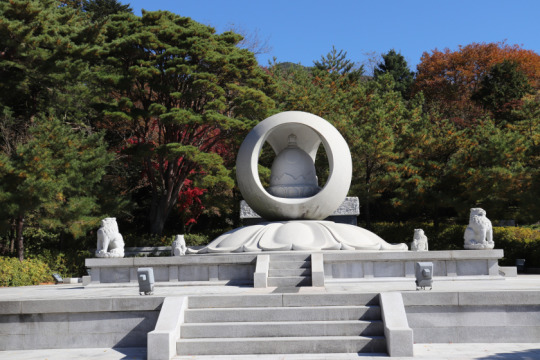
we looked around for a bit and then crossed a beautiful bridge over to the “Main Gate” of the Temple. At first i just thought it was like any other ancient door, but as we went through i noticed that on the two inner walls stood two giant statues (two for each side) I don’t know what they were since i am fairly ignorant on Buddhism, especially when it comes to deities, but i think at least from their poses and expressions they must be guardians.
From the door to the temple it doesn’t take much, but if you’re like me you will definitely get sidetracked but the little stalls selling souvenirs and Religious artifacts (?) however i didn’t take long looking at them since my husband said we couldn’t buy the little sword, why they sell a mini sword is beyond me but it was cute. We then were faced with the Breathtaking view of the Temple stairs. They’re these huge stone steps that go all the way to the top of the temple and were lined with beautiful potted flowers. According to my husband, these steps are the original ones and haven’t been restored. I don’t know how true that is since the Korean Tourism website they say that the temple has been destroyed and reconstructed multiple times be it from fires or war, however, they make no mention of the steps, but the Temple’s website does say they were built in 751 and have been in continuous use until they were closed off to the public to preserve their already fading characteristics.
Then we officially entered the Temple, it’s a beautiful place, imagine Gyeongbokgung since it follows the same architecture and layout as most Korean ancient structures but much more colorful. The red and yellow of the walls and the beautiful paintings on the roof are mesmerizing. the inside of this first hall had a magnificent golden Buddha, as most buddhas are. you aren’t allowed to take pictures inside the rooms so you’ll just have to go and see it for yourself since whatever description i can give will do it no justice.
on the outside, there are these two huge stone pagodas. One of them is called Dabotap and the other one is called Seokgatap, according to the temples official website they are Korea’s two most renown pagodas.
“The two pagodas were built at the same site to reflect the content of the Saddharmapundarika Sutra (The Lotus Sutra), in which the Dabo Buddha (“Buddha of the past”) stands beside Sakyamuni (“Buddha of the present”) to prove that his Buddhist sermon is right.” -temple website.

Dabotap pagoda certainly catches one’s eye at once due to its unique shape, varying from the more traditional structure Seokgatap and most pagodas have. Because of this people aren’t entirely sure how many stories it has. It is a beautiful structure, it has so many different shapes and structures within its self yet the still look so harmonious and pleasing.
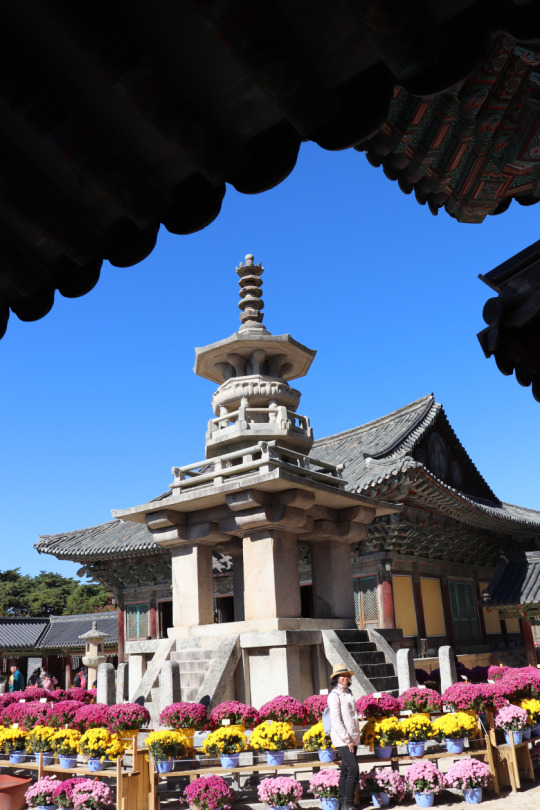
Seokgatap is a more traditional and simple type of pagoda, but that doesn’t mean it’s any less beautiful. The Pagoda from its construction many centuries ago remained in near perfect conditions until 1966 where robbers damaged the structure, i assume they were looking for reliques that are often stored inside the stone, luckily when they were repairing it the right people found multiple artifacts and reliques now deemed national treasures like the pagodas themselves. I definitely recommend reading the website since it has amazing historical facts.
After this main hall, we followed the rest of the temple’s layout each as beautiful as the one before. We spent a few more minutes looking around and admiring the scene but alas we had to move along to the rest of the places we had planned for the day.
Seokguram Grotto.
At the top of the mountain, almost a 40-minute drive from Bulguksa temple where all you really see is the mountain full of trees, all changing color, especially the gingko trees golden yellow and cascading like a shower of gold flakes. Aside, from the autumn scene, it was all so reminiscing of Colombia, with its lush green mountains and winding roads. We arrived at a parking lot, paid the entrance fee and walked through a small forest path we arrived at a small crook in the mountain where we found ourselves facing two small temple-like buildings hidden by the trees. We made our way to the uppermost building where you can see the Buddha of Seokguram grotto. Unfortunately, you can’t take pictures inside but is such a magnificent view. It’s a huge Buddha made of stone, everything is made out of stone, carved with such amazing detail.
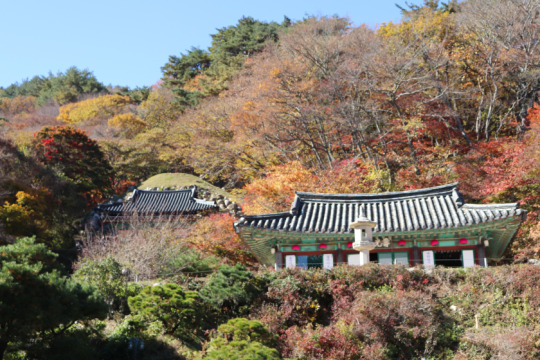
Aside from the amazing masterpiece that is the Buddha, the view from this place is simply breathtaking, i didn’t realize how close we were from the ocean.
The other buildings were a prayer hall, a souvenir shop, and a bathroom.
Golgulsa Temple
Located at the foot of Mt. Hamwol, Gulgulsa is the only temple cave in Korea. The temple was built out of solid rock during the 6th century by Saint Gwang Yoo and some accompanying monks, and was designed according to the architectural structure of India. –Visit Korea
Our Third stop was a small temple i convinced my husband to go to since it isn’t actually one of the bigger more popular temples, on the contrary, it’s a small and very private temple nestled in between the forest. the place is smaller than any other temple we’ve been, it feels more private and it is much less “touristy” feel than Bulguksa or other temples we visited. This place first caught my attention because on the map we had the picture they displayed had monks doing martial arts, this is the first time i see something like it on any temple, but then when doing some research on it aside from its peaceful setting and the Buddha Carved on the side of a mountain, they had a statue of a dog that used to live there, this made me want to go even more.
The entrance was lined with statues of monks in various martial art positions, i didn’t get a chance to take a picture of them because on both our way in and out i was preoccupied eating some pound cake since at this point we hadn’t had anything to eat all day and i was starving.
The first few buildings you encounter i assume since we didn’t go in, seem to be the study halls for the monks and participants of the Temple stay, and imagine the cafeteria.
After a short walk up a hill, we were met by two statues. one was Buddha and the other of a dog.
The Dog was called Donga or Monk Donga, he was born in the winter of 1990 and since he was a puppy he dutifully followed the monks on their prayers, he also loved people and helped guide them to the temple, and contrary to his breed’s natural behavior -he was a Jindogae, and they apparently are used for hunting and guarding- he never hurt another living creature. He was such a good dog that when he died in 2010 the human monks made him a statue so he could reincarnate as a human. I got a bit choked up as i pet his statue.
Then we went to the prayer halls and caves, they are all located on the side of a small mountain. the first hall you encounter is where the monks perform their martial art, then as you continue up the stairs you will see different little grottos carved into the rock.
At first, as we went up the main stairs i was fine, but then to get to the Maya Tathagata Buddha the path got more precarious as we had to actually climb up the rock walls while holding on to the safety ropes which are very high up for someone who is extremely afraid of heights. the Maya Tathagata Buddha is magnificent, carved out of the rock by hand.
Unfortunately, when we got there, we were too high up for my comfort and i immediately sat down on the prayer platform which i don’t think was appropriate but i was too terrified to move and this seemed like the safest place to be. i was too scared to even look up at the Buddha and was only able to look down at the platform banks while my husband took the pictures.
Tomb of King Munmu (Great King Rocks)
A few minutes drive from Golgulsa temple through the countryside we arrived at the beach to visit our next sight, the tomb of King Munmu. King Munmu was the first 30th king of the kingdom of Silla responsible for unifying the three kingdoms (Baekje, Silla, and Goryeo) hence becoming the first King of great Silla. You would assume that such great historic King should have a huge tomb made in his name, yet, if you didn’t know what you were looking for you’d just see a bunch of rocks of the coast.
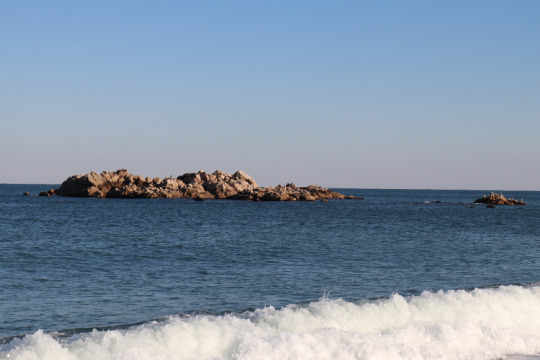
The Tomb of King Munmu is an unassuming group of rocks, close to the shore, that to the unknowing just seem like home for seagulls, but if you look closely to you will notice that on top of the biggest rock there’s what seems like a marble tombstone, i don’t know for sure what it says but it must have the King’s name. you see, According to the legend King Munmu gave instructions that after his death, he should be buried at sea where he could become a Dragon to protect Silla from Japanese invasions.
The rocky island, about 200m in circumference, is divided by a cross-shaped waterway, forming a pool at the center, at the bottom of which is a granite stone 3.6 meters long, 2.9 meters wide and 0.9 meters thick. Legend has it that the remains of King Munmu’s cremated body are buried under this rock. Historians still debate whether the ashes of the King Munmu were scattered or stored in an urn and placed under the rock.- Visit Korea
Following a few photos of the tomb, a few pictures of us and a quick history lesson from my husband, we walked along the beach just looking at the water and taking in the view, since aside from the tomb there isn’t anything else of particular significance other than a few seafood restaurants. We walked for a bit when we saw a group of grandmothers/old ladies, three sitting together, one sitting behind them to the right and another a little farther away to the left, at first i just thought they were having a picnic at sea or just sunbathing, but then i noticed the one to the right was banging a drum, the one to the left seemed like she was crying or pleading and the three in the front where all praying and bowing. I quickly realized they practice all Korean religion, the original religion before Buddhism or any other, also known as Shamanism. It was the first time i saw this in real life, only seeing it before in movies or shows so it was a bit surprising, just because it’s something so unknown to me.
Columnar Joint Zone of Yangnam.
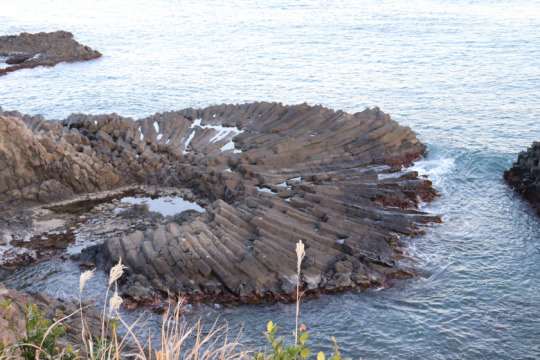
Our second to last Sight was the columnar joint zone of Yangnam, Its a geological formation caused by a pool of lava that got cooled down int’ its present shape. It looks like piano keys or steps, this particular one is called buchae the Korean word for the hand fan since the circular shape of this formation makes it look like a half-opened hand fan.
Gameunsaji Temple Site
Not far from the Tomb of King Munmu, but in the middle of seemingly nowhere, where all you can see are mountains, farmland, and the highway you will find the Gameunsaji Temple site. However, all you will actually see are the pagodas because nothing remains another than these huge three-story stone pagodas. The temple was ordered to be constructed by King Munmu, whose purpose was to have a place where he could pray for Silla’s guidance and protection from invasions. He died before they finished its construction but his son King Sinmun completed and named the temple in honor and respect for his father.
We stayed in the parking lot in front of the pagodas waiting for the sun to fully set so we could both see the pagodas lit up against the darkness of the night and because we wanted to see the stars, something we don’t get to do in Seoul but here, in the middle of nowhere, it was perfectly dark for stargazing.
Woljeong bridge.
When we got back to the city we made one last stop, Near the royal tombs there is a beautiful covered bridge called Woljeong, i don’t know anything about it since i only saw pictures of it, and since it was a bit dark and cold we didn’t walk up to it. All i know is that it was built sometime during Silla, it was destroyed and rebuilt and now its closed off to the public which just means you can’t cross over it, you can only admire it. next to the bridge there’s a traditional village where you can rent a hanbok and take pictures in traditional looking homes, a restaurant and a very cool looking Cafe, but due to the time it was already closed and the cafe although visually very inviting we weren’t in the mood for coffee so we didn’t bother going in.
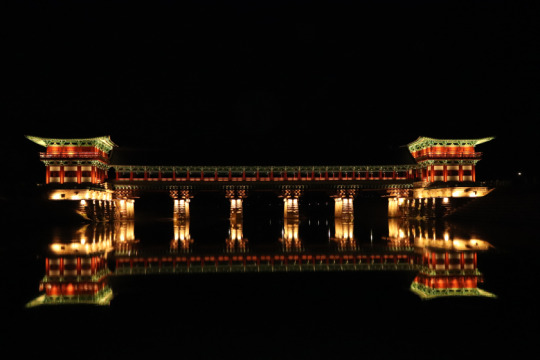
I took many pictures of the bridge but sadly we couldn’t last long because it was cold and because we were hungry again so we headed back to the hotel and look for somewhere to eat dinner.
Despite the fact that we arrived relatively early, actually, at around 7 pm we noticed that every restaurant and was either about to close or closed already. we drove all over the place trying to find somewhere to eat, without any luck. we even went to hansot – a homestyle fast food restaurant- that earlier that day we had noticed closed at 9 pm but when we arrived at 8 pm on the dot, the lady was already closing, our only to options at that time was either McDonalds or convenience store food, and given that my husband was already tired of Mcdonalds we at the convenience store which compared to American 7/11 it’s actually pretty good because they sell lunch boxes that come with rice, and vegetables and whatever type of protein you chose, so even though we were a bit disappointed we still ate very well and understand that not every city is like Seoul where people tend to eat very late so restaurants close very late, so if you ever go to Gyeongju just keep in mind that if you want to eat at a specific restaurant you should go before 7pm.
And that was how our day ended, with a belly full of quick food and tired from a day of exploring.
*All pictures are taken by me and are not edited.
To The South, Second Day. Gyeongju Day 2 Day 1 For our second day in Gyeongju, we rented a car because we were going to visit some places that were fairly far away from the city and from each other, plus, Gyeongju doesn't have a subway system, there aren't many buses and taking a taxi all the way there would be very expensive.
#Asia#beautiful#Buddha#Buddhism#East Asia#expat#fun#History#Korea#Korean History#Life#living abroad#living in korea#nature#photographs#sea#south korea#travel#traveling#Visit Korea
4 notes
·
View notes
Text
Buda y Thanos

(seeh…Marvel tampoco estaba muy convencida, parece) Por sea acaso SPOILER ALERT
Como al parecer un tercio del planeta, este fin de semana fui con mis hijos a ver Avengers: Infinity War. No voy a spoilear demasiado (espero) salvo para contarles que el personaje de Thanos, quién es el enemigo de los Avengers (vamos, desde la primera está apareciendo como el malo, no es un spoiler) es muy diferente en su motivación que el de los Comics.
El Thanos de los Comics es, esencialmente, un romántico. Enamorado de la Muerte, que en Marvel es una jóven bella, unifica esencialmente las dos pulsiones y termina siendo uno de los villanos más efectivos justamente porque no hay nada que se compare, en el cosmos, que terminar acostándose con la Muerte. En ese sentido, si bien parece irracional, sus acciones tienen su lógica; demente y megalómana, pero la tienen.
El Thanos de la pantalla es, tristemente, más pseudoracional y familiar. Pseudoracional porque si bien los problemas que lo motivan están más o menos pensados de forma racional (la pobreza de las condiciones de vida y la sobrepoblación del universo) su plan es simple: matar a la mitad de la población con un guante que puede hacer cualquier cosa. Cualquier cosa. Es decir, con la gema de la Realidad, en teoría, puede modificar la realidad. No necesita matar a la población, porque puede crear comida y riquezas de la nada. Pero de alguna manera, aún teniendo el poder del universo literalmente en su mano, no puede salir de la lógica capitalista de la mano invisible de Adam Smith. Quizás por eso, en el final (que no voy a spoilear) mi hijo Fran me dijo “nah, en dos minutos cambian todo si tienen que seguir currando”. El capitalismo es más fuerte que la imaginación cósmica, me temo.
Pero por otro lado, es un pensamiento familiar el que Thanos muestra: el que un problema complejo como refugiados, sobrepoblación, hambre, pobreza, etc. es algo que un hombre mayor y autoritario rápidamente puede resolver. No hay que ir mucho más lejos que “Voy a construir una muralla” para encontrar ejemplos. Y por supuesto, como solución no tiene sentido…salvo que consideremos que el problema que la muralla resuelve es el de la inmigración. Pero si nos ponemos a observar, el problema que resuelve es el de dar una forma a los miedos y angustias de la gente para aprovecharse de ellos.
Este miedo, esta tentación de que todo sea simple se puede ver en todos los aspectos de la vida. Pero aparece muchísimo en los discursos Budistas occidentales. Desde el “todo es ego” (que, ya hemos escrito, directamente no existe en el Budismo) hasta la idea de que el Budismo es X, no Y, aunque Y aparezca en mil textos (generalmente un conjunto de valores o textos que coinciden, oh sorpresa, con los que están haciendo esa declaración) está siempre presente esa tentación de reducir todo a algo simple, entendible, que no nos desafíe.
¿Las deidades, los ogros y las ninfas de los discursos budistas molestan? Seguramente eran metáforas, o algo cultural. ¿Qué el karma atraviese vidas suena bizarro? Dejémoslo de lado, es algo de los Indios.
El Buda mismo advirtió varias veces y a través de los diferentes cánones sobre esta tendencia, esta necesidad de simplificar todo. Tomemos el Vacchagotta Sutta, dónde Vacchagotta le quiere hacer decir al Buda que el cosmos es eterno o no eterno, pero el Buda insiste: no es tan simple como que exista o no exista. Vacchagotta quiere tener una respuesta simple, clasificable y el Buda claramente resiste eso, porque considera que esa tendencia no tiene sentido. O el Saddharmapundarika Sutra (el famoso Sutra del Loto Mahayana) dónde en su capítulo 2 Sariputra tiene que insistir tres veces al Buda para que explique su punto de vista: el Buda explica repetidas veces que se corre el riesgo de caer en el reduccionismo, de no entenderlo. Aún en los Tantras se considera que la enseñanza es compleja. En el Guhyasarvacchindatantra se dice:
¡Si aún los nobles discípulos, los Budas Solitarios Y los mismos Bodhisattvas No actualizan el Cuerpo del Dharma! Esto es dado que la enseñanza es Profunda
Hay muchas cosas en la vida que son de una complejidad irreductible. Y parte de la sabiduría, creo, es entender que estas cosas son complejas, que requieren años y años de estudio y práctica. Y que aún con los años de estudio, práctica y disciplina nunca las vamos a agotar: el Budismo tiene 2.500 años de desarrollo initerrumpido: es muy difícil solamente conocer el nombre de todas las escuelas importante, ya no saber aún de forma superficial lo que enseñaban. Por eso en general, cuándo enseño un texto o una práctica intento siempre contextualizar de quién provino la enseñanza (”Khenpo Pema, cuándo me enseñó el texto me dijo que…”) porque es muy posible que haya otra enseñanza Budista que lo contradiga.
Pero siempre vá a existir la tentación de que, en realidad, es mucho más fácil. Que no es necesario estudiar y practicar, que una solución pensada en diez minutos vá a ser la que nadie en 2.500 años generó. No por nada tenemos un grupo de gente que considera que Thanos, un alien púrpura que es abiertamente genocida, quizás tenía razón: http://www.ladbible.com/news/news-infinity-war-fans-are-asking-if-thanos-was-right-20180502
Creo que, como Budistas, tenemos que desconfiar de las soluciones simplistas. En las palabras (atribuidas, nunca probadas) de Einstein “Todo tiene que ser tan simple como sea posible, pero no más simple que eso”.
1 note
·
View note
Photo




M A H A Y A N A B U D D H I S M
Origin
Great Vehicle (Northern Buddhism) Northern India 2nd Century C.E.
Founder
Siddhartha Gautama (known as the Buddha, or the Awakened One.)
Sacred Text
Perfection of Insight texts (Prajñã-pãramitã Sutras)
Saddharmapundarika Sutra (Lotus of the Good Law Sutra, or Lotus Sutra)
the Vimalakirti Sutra, the Avatamsaka Sutra (Garland Sutra),
the Lankavatara Sutra (The Buddha's Descent to Sri Lanka Sutra),
Prajñaparamita (Perfection of Wisdom)
Bodhicaryavatara, 'Entering the Path of Enlightenment’
Beliefs and Doctrines
compassion (Skt: karunã) and insight (Skt: prajñã)
Bodhisattva (Skt; Pali: Bodhisatta) means an enlightened being or one who is oriented to enlightenment.
Six Paramitas
• generosity (dana)
• morality (sila)
• patience (ksanti)
• courage (virya)
• knowledge (jhana or dhyana)
• and intuitive insight (prajna).
0 notes
Text
Nicheren Essay
Nicheren Essay
Nicheren (or Nichiren) Buddhism was a sect unique to Japan that challenged the existing notions of Buddhism as part of a societywide upheaval of intellectual and religious understanding. The essence of Nicheren Buddhism is the reversal of the original message of Gautama Buddha, which Nicheren considered to have been used to exalt and protect the state to the detriment of individuals. Instead, people should study ways of achieving material and physical security and ease by following the Lotus Sutra (Saddharmapundarika-sutra). Nicheren (originally Zennichi and also known as Zenshobo Rencho) was the son of a poor fisherman from the Awa province.
Read more on http://www.essayempire.com/examples/history/nicheren-essay/
0 notes
Quote
i express my devotion to the perfectly endowed Mystic Law of the Lotus Sutra.
0 notes
Text

FACING EVERYWHERE: THE TEACHING OF
THE MIRACLES OF AVALOKITESVARA
24.1 Then the bodhisattva mahäsattva Aksayamati rose from his seat, removed his upper robe from one shoulder, knelt on his right knee, and with his hands together in homage bowed toward the Bhagavan and asked the Bhagavan, "Bhagavan, why is the bodhisattva mahäsattva Avalokitesvara called Avalokitesvara?"
24.2 The Bhagavän said to the bodhisattva mahäsattva Aksayamati, "Noble one, if the hundred thousand quintillion beings in this world who are experiencing suffering were to hear the name of the bodhisattva mahasattva Avalokitesvara they would all become freed from that mass of suffering.
"Noble one, if those who possess the name of the bodhisattva mahāsattva Avalokitesvara were to fall into a great mass of flames, they would all, through the splendor of the bodhisattva mahäsattva Avalokitesvara, be freed from that burning great mass of flames.
24.3 "Noble one, if they call out to the bodhisattva mahāsattva Avalokitesvara when they are swept away by rivers, those rivers will bring them to shallow waters.
"Noble one, if a hundred thousand quintillion beings were to set out to sea in a ship, sailing to find cowries, gold, jewels, pearls, beryl, conch, crystal, emeralds, coral, white coral, red pearls, and so on, and if a tempest blew them to the island of the raksasis, and if among them one being would call on Avalokitesvara, they would all become freed from that island of the raksasis.
24.4 "Noble one, if someone being led to execution were to call on Avalokitesvara, the weapons of the executioners would break into pieces and be scattered around.
"Noble one, if this world realm of a thousand million worlds were to be filled with yaksas and raksasas, none of them would even be able to look angrily at someone who possesses the name of the bodhisattva mahāsattva Avalokitesvara.
~ The White Lotus of the Good Dharma
(Saddharmapundarika)
#Avalokiteshvara#chenrezik#buddha#buddhist#buddhism#dharma#sangha#mahayana#zen#milarepa#tibetan buddhism#thich nhat hanh#amitaba buddha#Padmasambhava#Guru Rinpoche#manjushri#vajrasattva#vipassana#vajrapani#vajrayana#bodhidharma#buddha samantabhadra#green tara#enlightenment spiritualawakening reincarnation tibetan siddhi yoga naga buddha#Dzogchen
4 notes
·
View notes